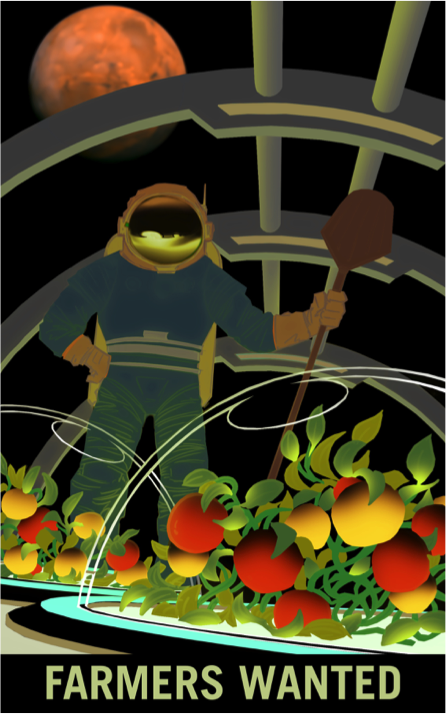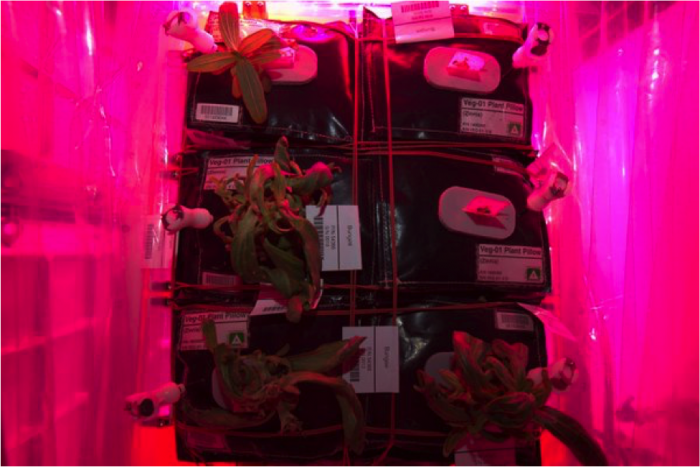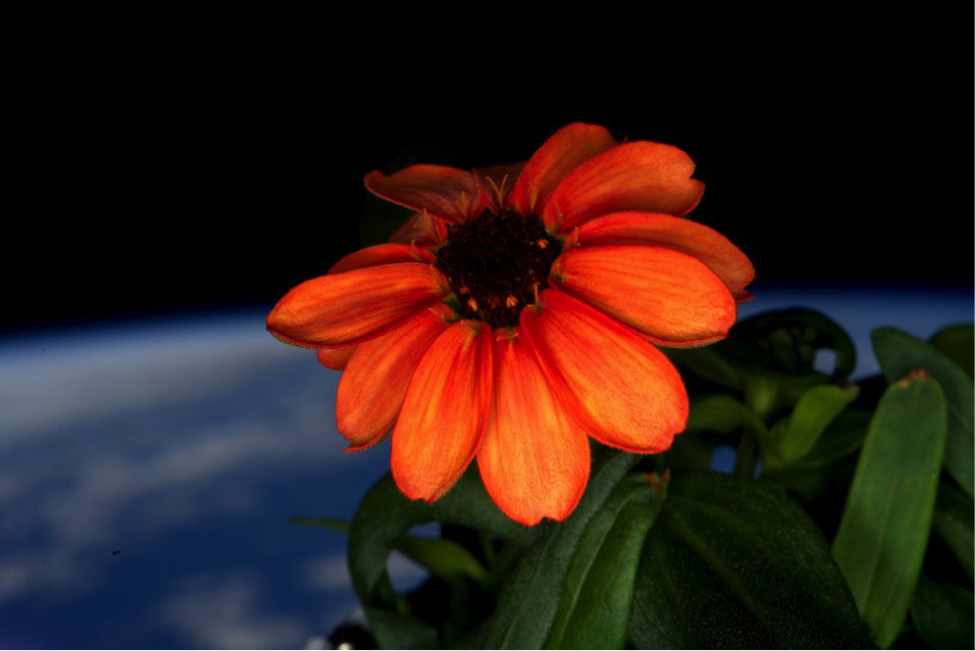Part of a series commissioned in 2009 by NASA for an exhibit at the Kennedy Space Center, the “Farmers Wanted” poster above is only one of many advertising for humanity’s resettlement on Mars. The series, Mars Explorers Wanted, includes other posters with text such as “We Need You”—an astronautical replica of Uncle Sam and the infamous army recruitment poster—and advertisements for Mars teachers, technicians, and explorers. Although depicted as archetypes of Space Western sci-fi, these posters are no longer far from reality. Since the 1960s NASA, the Russian Space Agency (Roscosmos State Corporation), and the ESA (European Space Agency) have been developing tools and methods to take humanity’s endeavors deeper into the unknowns of outer space and for longer, possibly permanent, periods of time. An integral part of this increasingly global, or even interplanetary, mission is not only designing equipment able to withstand the speculated conditions of outer space environments but also designing environments and ecologies to sustain those who venture above.

In 2009, David Valentine, Valerie Olson, and Debbora Battaglia argued that “being earthbound is not a limitation, and it should not be one for anthropologists” (2009: 11). And while those who are not earthbound are few and far between, outer space provides an entry point to engage in anthropologies of alienness and belonging (Battaglia 2012a, 2012b), markets and economies (Valentine 2012), ecologies, natures, systems and environments (Olson 2010, 2012; Helmreich 2012), and place and world making (Messeri 2016; Valentine 2016). I use this post as an outlet to explore my research interests, which are situated at the crossroads of scientific and ecological design, entanglements between plant and human life, and agricultural futures.
The On-Orbit Gardener
In August 2015, US astronauts Scott Kelly and Kjell Lindgren were among the first American astronauts to consume crops grown in low Earth orbit (LEO) on the International Space Station (ISS). The “Outredgeous” red romaine lettuce, grown as a part of NASA’s Veggie experiment, was deemed by NASA as one giant leap for mankind in securing future “pioneers with a sustainable food supplement—a critical part of NASA’s Journey to Mars” (NASA 2016). However, these leafy greens were not the first to bring some color to the chambers of the ISS. In 2012 US astronaut Don Pettit cultivated life—in outer and cyber space—in the form of a zucchini plant. In a blog post titled “Diary of the Space Zucchini,” Pettit poetically gives life to the “zucchininaut” and its “refined observations of living on orbit” (Battaglia 2014b). Even before Pettit, NASA and RosCosmos had brought seeds and other viable stages of plant life aboard space shuttles to study microgravity effects on plant biology.[1] These seedlings, some of them now sprouted and sprinkled across Earth, invite us to imagine ecologies, environments, and their futures that not only bring plant matter(s) into an otherwise considered lifeless (outer) space but help conceptualize what agroecological design for terra- and extraterrestrial futures entail.
Consider the recent case of Scott Kelly and the presence of mold growing on the petals of zinnia flowers onboard the ISS. A part of the Veggie project, a series of plant growth units deployed on the ISS with purposes of producing crops to provide crews with nutritious and fresh food, the zinnia flowers were launched with expectations to understand how inedible plants grow in microgravity. Ultimately, this would provide alternative agroecological insights to methods of crop production back on Earth and inspire new models of extraterrestrial greenhouses and habitats. Resource restriction, methodological rigor, and sustainable efforts to conserve water led NASA’s mission control and the principle investigators of Veggie to strictly schedule the watering of the zinnias. However, in December 2015, a mechanical mishap allowed water to leak onto the zinnias. Moisture coupled with the humidity in growth chambers spurred the wilting of leaves and encouraged the mold growth. Fans were deployed quickly in order to dry out the zinnias and prevent mold from spreading, yet another problem occurred. Now the zinnias were too dry and in immediate need of water, but the next scheduled watering would be too late.
I think that would be too late … You know, I think if we’re going to Mars, and we were growing stuff, we would be responsible for deciding when the stuff needed water. Kind of like in my backyard, I look at it and say “Oh, maybe I should water the grass today.” I think this is how this should be handled. (NASA 2016)

And so with Scott Kelly as advocate, the autonomous “On-Orbit Gardener” emerged, and two of the four zinnias continue to orbit Earth (NASA 2016). To support the on-orbit gardener, NASA developed a one-page brief guide for the Veggie team on basic care for the zinnia flower, thereafter placing all judgments and capabilities of the experiment in the hands of the gardener. No longer was Kelly solely an astronaut implementing outer space experiments, but by necessity he had also become a gardener attentive to the intermittent of life. An unexpected turn in the Veggie experiment had reminded NASA astronauts and crew that plants are sensitive and responsive to their environment, not easily grown within systematic confines of science.
The newly astronaut-become-gardener invites exploration of the entanglements between technology, built environments and ecologies, and human/bodily intervention. As Kelly is forced to transition into the role of a gardener, a shift occurs from a scientifically controlled experiment to an interaction that is symbiotic and fruitful. Battaglia notes this initial disjuncture as “trans(re)lation,” an unfamiliarity or experience that opens “new angles onto organisms and things that relate differently than expected in extreme environments” (2012a: 1090). This moment of trans(re)lation can be useful for thinking through ecological design that is careful and mindful of alternative and extreme spaces for agriculture. In the case of Scott Kelly, the unexpected mold formation opened up the need to think anew with the project’s ecological and scientific design.
History of Outer Space Ecological Design
In the 1950s and 1960s, NASA scientists and US ecologists introduced “cabin” and “built” ecologies for outer space travel and future colonization. These spaces were carefully crafted architectural and ecological designs for closed and prolonged human life in outer space that conceptually emerged out of the growing fear of nuclear catastrophic destruction and the bomb shelter craze of the 1950s. The ecologically attuned scientist and architect could invent the ultimate escape (to outer space and underground) for social and environmental living should humans need one from any numbers of catastrophes headed our way (Anker 2005).
Cabin ecologies eventually came to mirror more ecologically inclined means of living on Earth. The mystique of living on a spaceship orbiting Earth led Buckminster Fuller, an engineer for and admirer of the military, to theorize about living aboard a “spaceship Earth.” Population biologists and other inspired supporters turned to astronauts and cabin ecologies as exemplary of how to live on Spaceship Earth, an argument that aided the perplexing logic behind neo-Malthusian arguments for sustainable governance (Anker 2005). If Earth, the (space)ship sailing through the seas of outer space, was in a state of flux and instability because of humanity’s perceived overpopulation and resource overconsumption, then recognizing a need to limit the number of astronauts living within built cabin ecologies was seemingly important.
Biosphere II was the best-known experiment, but one of many, testing this theory out. Biosphere II, named after the Biosphere I (planet Earth), was the most ambitious effort to live in an artificial closed-ecological habitat. In the desert of Arizona, eight people spent two years living in this supposedly sealed ecosystem that attempted to replicate Earth as a system of ecologies. However, troubles, particularly with CO2 and oxygen levels, led “to an unbalanced fauna and flora” and supplemental aid from outside of Biosphere II had to be incorporated (Haeuplik-Meusburger et al. 2014: 138). While considered a failure (along with the eventual intellectual turn against neo-Malthusian environmentalism), Biosphere II continues to serve as a reference for designing agricultural systems in built environments on Earth and in space. Sabine Höhler notes these artificial ecological designs as technonatures and argues a need to attune into the hardened, technological, and scientific aims to control and replicate the environment under constrained systematic and cybernetic systems. She states, types of designed ecologies under scientific guidance “inspired a rigid classification and selection of life and nature in order to establish a rational scientific basis for determining what would be useful and what was redundant, what was to be conserved and what discarded” (2008: 76).
For the Future
Despite an experiment systematically and scientifically inclined, an unintended ecology still emerged inside the ISS. As Michael Oman-Reagan has stated, “[plants] are still engaged in an intimate relationship of breath with the humans on the space station,” and the presence of mold—possibly health threatening—made visible an ecosystem unintended, unexpected, or otherwise (2015: 6). Further, Haeuplik-Meusburger and colleagues argue, “plants can ‘humanize’ technical spaces because they are not functions of human will but symbiotic partners” (2014: 149). Even if only inside the zinnias’ terrain, like Biosphere II and built habitats previous, unintended ecologies still emerge when the flux of human and plant engagements are at play with the systematicity of science.
Regard Kelly’s encounter as an entry point to redefine agroecological design and futures and to redirect ecological design histories. At a time where geopolitical discussions of terra- and extraterrestrial grounds are reinventing agricultural methods and technologies—only weeks after SpaceX revealed their plans for the colonization of Mars and scientists declared that we are entering a new geological epoch defined by humans’ impact on Earth—I believe there is urgency for anthropologists to critically engage with the rapid spatial, technological, and occupational transition of the farm, foodstuffs, and food supply. After all, “we are only because they are” (Myers 2016).

Melanie Ford is a first-year graduate student in the department of anthropology at Rice University. She is interested in ecological design and emerging agricultural technologies, spaces, and futures.
Note
[1] In 1971, Roscomos constructed the first greenhouse in outer space on Salyut 1.
References
Anker, Peder. 2005. “The Ecological Colonization of Space.” Environmental History 10: 239–268.
Battaglia, Debbora. 2012a. “Coming in at an Unusual Angle: Exo-Surprise and the Fieldworking Cosmonaut.” Anthropology Quarterly 85, no. 4: 1089–1106.
Battaglia, Debbora. 2012b. “Arresting Hospitality: The Case of the ‘handshake in Space.’” Journal of the Royal Anthropological Institute 18, no. s1: S76–89.
Battaglia, Debbora. 2014a. “Cosmos as Commons: An Activation of Cosmic Diplomacy.” E-Flux, no. 58.
Battaglia, Debbora. 2014b. “Diary of a Space Zucchini: Ventriloquizing the Future in Outer Space.” Platypus: The CASTAC Blog, 7 July.
Haeuplik-Meusburger, Sandra, Carrie Paterson, Daniel Schubert, and Paul Zabel. 2014. “Greenhouses and Their Humanizing Synergies.” Acta Astronautica 96: 138–150.
Helmreich, Stefan. 2012. “Extraterrestrial Relativism.” Anthropological Quarterly 85, no. 4: 1125–1139.
Höhler, Sabine. 2008. “‘Spaceship Earth’: Envisioning Human Habitats in the Environmental Age.” German Historical Institute 42: 65–85.
Messeri, Lisa. 2016. Placing Outer Space: An Earthly Ethnography of Other Worlds. Durham, NC: Duke University Press.
Myers, Natasha. 2016. “Photosynthesis.” Cultural Anthropology, 21 January.
Olson, Valerie A. 2010. “Political Ecology in the Extreme: Asteroid Activism and the Making of an Environmental Solar System.” PhD diss., Rice University.
Olson, Valerie A. 2012. “Political Ecology in the Extreme: Asteroid Activism and the Making of an Environmental Solar System.” Anthropological Quarterly 85, no. 4: 1027–1044.
Oman-Reagan, Michael. 2015. “The Social Lives of Plants, in Space.” Astrosociology Research Institute. Astrosociological Insights Newsletter, 4–8
Valentine, David. 2012. “Exit Strategy: Profit, Cosmology, and the Future of Humans in Space.” Anthropology Quarterly 85, no. 4: 1045–1068.
Valentine, David. 2016. “Atmosphere: Context, Detachment, and the View from above Earth.” American Ethnologist 43, no. 3: 511–524. doi:10.1111/amet.12343.
Valentine, David, Valerie A. Olson, and Debbora Battaglia. 2009. “Encountering the Future: Anthropology and Outer Space.” Anthropology News 50, no. 9: 11–15.
Rainey, Kristine. 2016. “How Mold on Space Station Flowers Is Helping Get Us to Mars.” NASA, 12 January 12.
Cite as: Ford, Melanie. 2016. “Cultivating an Outer Space Ecology: Introducing the On-Orbit Gardener.” EnviroSociety, 21 November. www.envirosociety.org/2016/11/cultivating-an-outer-space-ecology-introducing-the-on-orbit-gardener.
